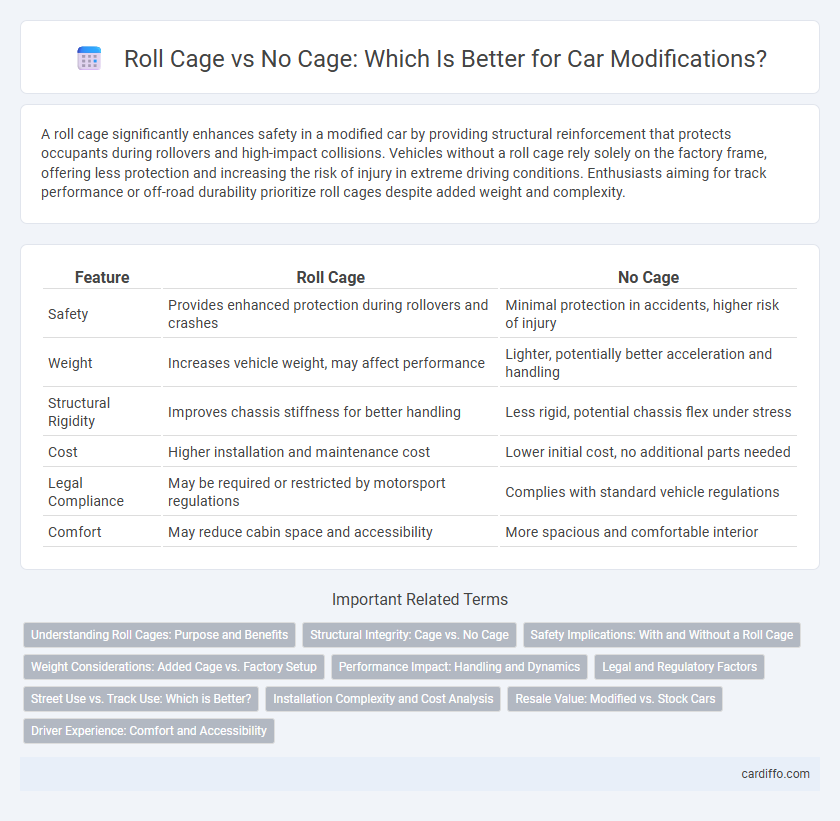A roll cage significantly enhances safety in a modified car by providing structural reinforcement that protects occupants during rollovers and high-impact collisions. Vehicles without a roll cage rely solely on the factory frame, offering less protection and increasing the risk of injury in extreme driving conditions. Enthusiasts aiming for track performance or off-road durability prioritize roll cages despite added weight and complexity.
Table of Comparison
| Feature | Roll Cage | No Cage |
|---|---|---|
| Safety | Provides enhanced protection during rollovers and crashes | Minimal protection in accidents, higher risk of injury |
| Weight | Increases vehicle weight, may affect performance | Lighter, potentially better acceleration and handling |
| Structural Rigidity | Improves chassis stiffness for better handling | Less rigid, potential chassis flex under stress |
| Cost | Higher installation and maintenance cost | Lower initial cost, no additional parts needed |
| Legal Compliance | May be required or restricted by motorsport regulations | Complies with standard vehicle regulations |
| Comfort | May reduce cabin space and accessibility | More spacious and comfortable interior |
Understanding Roll Cages: Purpose and Benefits
Roll cages are essential safety modifications designed to protect vehicle occupants during collisions or rollovers by reinforcing the structural integrity of the car's cabin. They reduce the risk of injuries by maintaining the shape of the passenger compartment, preventing collapse in severe accidents. Beyond safety, roll cages also enhance chassis rigidity, improving handling and performance in high-stress driving conditions.
Structural Integrity: Cage vs. No Cage
A roll cage significantly enhances a vehicle's structural integrity by reinforcing the chassis and distributing impact forces during collisions, reducing deformation and potential injury. Without a cage, the vehicle's frame is more prone to bending or collapsing under stress, compromising occupant safety and overall durability. Engineered steel tubing in roll cages provides critical support that maintains the vehicle's shape and rigidity under high-stress conditions, especially in off-road or racing environments.
Safety Implications: With and Without a Roll Cage
A roll cage significantly enhances occupant safety by providing a reinforced protective frame that minimizes cabin deformation during rollovers and high-impact collisions. Without a roll cage, the vehicle's structural integrity is compromised, increasing the risk of severe injury from roof crush or intrusion. Safety tests and crash data consistently show that roll cages reduce fatality rates by maintaining survival space and preventing collapse in extreme accidents.
Weight Considerations: Added Cage vs. Factory Setup
Adding a roll cage significantly increases the vehicle's weight compared to the factory setup, impacting acceleration and fuel efficiency. A typical steel roll cage can add between 40 to 100 pounds, depending on design and materials used, which may alter handling dynamics and suspension tuning. Manufacturers often balance structural rigidity with minimal weight, whereas aftermarket cages prioritize safety at the cost of added mass.
Performance Impact: Handling and Dynamics
A roll cage significantly enhances handling and vehicle dynamics by increasing chassis rigidity, which reduces flex during high-speed cornering and improves overall responsiveness. Vehicles without a roll cage may experience more body flex, leading to less precise steering feedback and compromised stability under aggressive driving conditions. Installing a roll cage optimizes weight distribution and chassis stiffness, directly benefiting performance on track or demanding road environments.
Legal and Regulatory Factors
Roll cages are often required or strongly recommended in competitive motorsports to meet safety regulations and improve driver protection during crashes, aligning with strict legal standards set by governing bodies like FIA and SCCA. Vehicles without roll cages may face limitations in race eligibility and can be subject to higher liability risks in street or track environments without certified safety reinforcements. Compliance with local vehicle modification laws and insurance policies frequently mandates roll cage installation to ensure legal operation and reduce penalties.
Street Use vs. Track Use: Which is Better?
A roll cage significantly enhances safety during track use by providing structural reinforcement that minimizes injury risk in high-speed crashes, which is less critical for street use where driving conditions are generally safer. For street driving, a roll cage can add unnecessary weight and reduce comfort, whereas a car without a roll cage offers better everyday usability and compliance with street regulations. Track enthusiasts prioritize roll cages for their ability to improve chassis rigidity and protect drivers during intense driving conditions, making them indispensable for competitive racing.
Installation Complexity and Cost Analysis
Roll cage installation demands specialized welding skills and precise measurement, increasing labor time and complexity compared to no-cage setups. Material costs for high-strength steel tubing and custom fabrication elevate expenses significantly, often ranging from $1,000 to $3,000 or more depending on vehicle type. Without a cage, modifications remain simpler and more budget-friendly, typically involving standard bolt-on parts with minimal structural alterations.
Resale Value: Modified vs. Stock Cars
Installing a roll cage significantly impacts the resale value of modified cars, typically attracting buyers seeking enhanced safety and track readiness. Stock cars without roll cages often retain higher resale value for everyday use, appealing to a broader market prioritizing comfort and original condition. Market demand shows that while roll cages add value in niche performance segments, they can limit appeal among general buyers, affecting overall market liquidity.
Driver Experience: Comfort and Accessibility
A roll cage enhances driver safety by providing structural protection but can reduce comfort due to limited cabin space and obstructed entry points. Without a roll cage, drivers benefit from easier accessibility and a more spacious interior, improving comfort during longer drives. However, the absence of a roll cage increases risk in collisions, affecting driver confidence and overall experience.
Roll cage vs No cage Infographic

 cardiffo.com
cardiffo.com